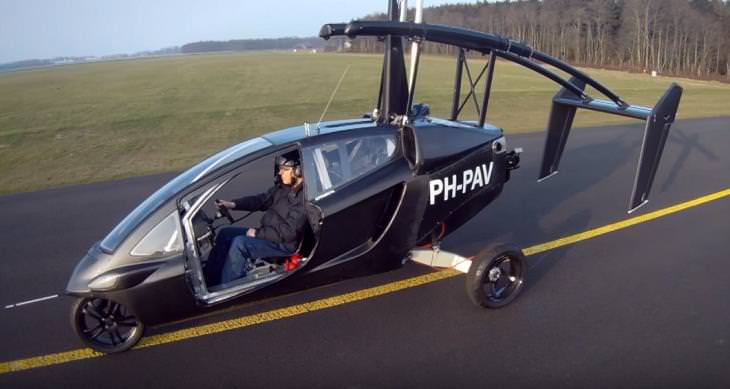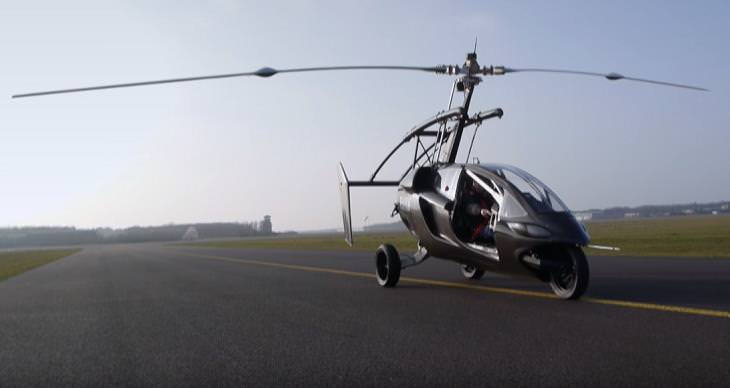

Jennings-Bates will be flying solo in his own automobile, while another pilot will be following close behind him in a 2nd flying car. Due to the fact that they intend to film the entire journey, they expect that it'll take around 3 months, although without the film crew following, it could actually be done in around 2 months.
The most stressful part about making such a journey will be having to keep a constant eye on the fuel gauge. PAL-V's flying car, 'The Liberty,' has a range of 817 miles (1,315km) while on the road, but only 310 miles (499km) while in flight mode. Jennings-Bates' accompanying pilot has already tested these limits on a particularly tricky stretch of Greenland, since the car only has just about enough fuel to get across it safely. Any hiccups could spell tragedy for everyone involved!
The pilot described this part of the journey as "the most nerve-wracking experience you’ll ever have,” due to the fact that you have to keep making constant and stressful calculations, whilst simultaneously piloting the flying automobile.

Conceived in 2001, PAL-V is a Dutch company that is putting all of its efforts into the creation of a road-friendly aircraft. Over 4 years, they went through quite a number of prototypes, until they eventually made a massive breakthrough in 2005. “We’ve really just innovated two older products, put them together, and created something new that works within today’s rules,” Jennings-Bates said.
At that point, a piece of technology known as 'DVC tilting' enabled the team to create a prototype with a narrow aerodynamic shape and a high center of gravity, which was also safe for humans to use. By combining this with a gyrocopter (the precursor to a helicopter), they eventually managed to successfully engineer a vehicle that is both sky and road safe. The reasons behind why they opted for a gyrocopter are because it's a relatively simple vehicle to manufacture, it's safe to fly, and can fold up easily.
The first prototype test flight was carried out in 2012, which was a resounding success. From there, PAL-V went on to develop a commercial version and began the process of production. Currently, the Liberty is available for preorder (with an astounding range of prices between $399,000 and $599,000), and has expected delivery times beginning as early as 2018.

The biggest challenge that Jennings-Bates and all flying cars seem to face is just how they're going to market them to the world at large. “We’ve seen cars fly a few times, but nobody’s sold very many of them,” Jennings-Bates said.
PAL-V are attempting to bypass this hurdle by sticking to two guiding principles: making a vehicle that's perfectly safe, and making one that's pretty simple to operate. “Whilst it looks like a helicopter, it’s actually much more simple than a helicopter,” Jennings-Bates said. “If you talk to a gyroplane instructor, they’ll often tell you they have students who can fly solo in 5-8 hours of training.”
Apart from the official PAL-V training that anyone who buys a Liberty will have to undergo, they'll also need both a pilot's and a driver's license, and those are only the requirements under current legislation, which wasn't exactly conceived with flying cars in mind. Any future changes to legislation could have quite the make-or-break impact on industries like this.
“That’s always been the missing piece of the puzzle,” Jennings-Bates said, regarding legislation. “How do we get it certified to be able to use it?” His company has managed to achieve success so far by designing it all from the ground-up. This meant that they were able to design their flying cars in accordance with the regulations, thereby creating a far more streamlined process.
However, there's a lot more that can be done to have clearer standards for both manufacturers and operators of flying cars. With the increased visibility that a global circumnavigation would bring with it, perhaps governments around the world will start seriously thinking about making regulatory updates, eventually allowing flying cars to revolutionize our daily commutes.
See PAL-V's flying car in action here: